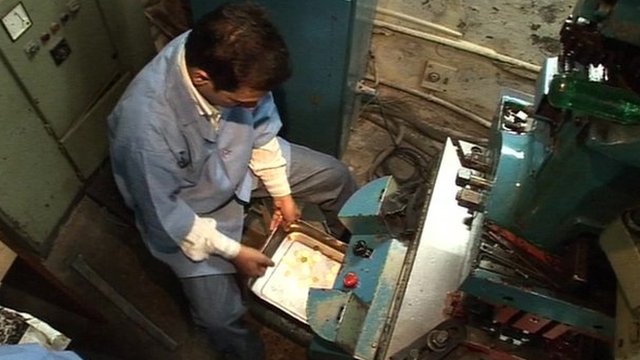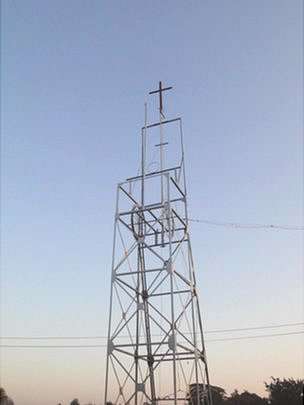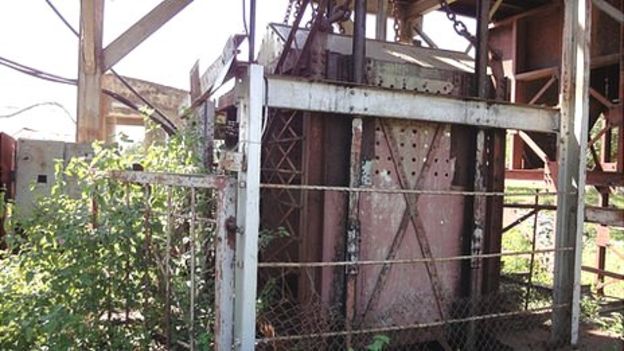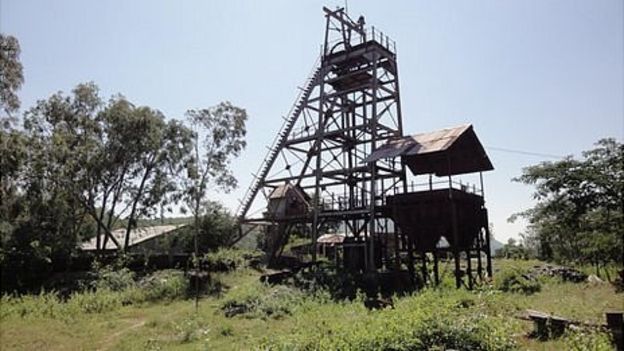Golden opportunity for old Indian mines

With gold prices at an dizzying high, Indian miners are turning to innovative ways to extract valuable ore.
India is the world's biggest importer of gold, buying a record 960 tonnes last year alone.
According to one estimate, Indian household vaults hold gold equivalent to 50% of the country's GDP.
You would think with those kind of figures, the nation must produce a significant amount of the precious metal domestically.
But domestic production is very low. The biggest problem is that India has consistently underinvested in gold exploration.
It was not always like this.
Historically, India was one of the great mining regions - and is home to one of the world's deepest gold mines.
Kolar of gold
In the southern Indian state of Karnataka, about two hours away from the city of Bangalore is a region called Kolar Gold Fields.
A hub of activity for over a century, the mines here shut in 2001 when gold prices fell to unprofitable levels.
The area is now in a state of neglect. Rusted rail wagons that once used to carry gold-bearing ore lie by the roadside.
The paths are overgrown with weeds, and buildings that used to house the mine workers and equipment are now derelict.
Old "headframes" - metal structures above the entry to the actual mine shafts - are the only indicator of the once thriving mining activity in the region.
Bharat Gold Mines Limited used to own the lease to mine an area that was about 16km long by 3km wide.
It was shut down nearly a decade ago as it became too expensive to continue operations.
Ignored ores
With little use of technology, only high-grade ores were mined to extract gold. Deeper ores which had smaller amounts of gold were ignored as the companies couldn't afford to mine them.
Also, as the mining sector was tightly controlled by the Indian government, it was difficult for private investors to bring in capital or technical expertise to the region.
Until now, only one government agency, Geological Survey of India, has been involved in exploration across the country.
So India has explored only 7-9% of their mineral resources, while countries such as Australia have achieved almost 100% geophysical and geochemical surveys.
India produces three tonnes of gold a year, while Australia mines 280 tonnes.
New evidence suggests that this gold belt is an underdeveloped resource.
Also in India's favour is the price of gold. As prices have jumped nearly 40% in the last year, many here feel that it makes economic sense to restart operations and revive the old mining town around it.

The community's church is dedicated to the 'Mother of Mines'
In 2001 the price of gold was at one of its lowest levels at $280 a troy ounce. But it has since risen dramatically and reached a record high of $1,920 a troy ounce in September 2011.
Diamond core
Drilling in test sites around the hills, exploration company Kolar Gold is mapping potential mines.
Using a process which uses diamond core drills, they take long cylindrical samples of rock.
These samples are then checked thoroughly for any evidence of of minerals, and some are sent to laboratories for further study.
Some even have visible specks of bright shiny gold.
While the main mining area is still owned by the defunct state-run company, the surrounding hills too could hold a lot more metal.
Listed on the Alternative Investment Market (AIM) of the London Stock Exchange, Kolar Gold says it has the international investors and technical expertise to extract even low-grade ores.
Richard Johnson is chief operating officer. Having spent many years in similar mines in Australia and South Africa, he says Kolar looks positive.
"Using a method called Induced Polarization (IP) survey, we lay out extensive wires in shallow pits across this vast area.

The old machinery, like this carriage down to the mine, has been left in disrepair
"We then send electrical current through it so the ground and the surfaces of metallic minerals get charged.
"Once we calculate the stored energy, we get clues into what minerals are there in the area."
Using this method, Kolar Gold has completed 40km of detailed surveys over its South Kolar area and found three significant anomalies.
This has given them "highly prospective" targets for follow-up drilling, rather than blindly looking for targets in the area.
10 grams
With technological advances in the mining industry, and the high price of gold, even finding six to eight grams per tonne would be worthwhile financially.
Kolar Gold hopes to find an average of 10 grams per tonne.
But mining is an expensive business.
It costs around $100 to drill about a meter of earth and an additional $50 to pay for a geologist to analyse the sample rock.
After paying £2.2m for a prospecting licence for South Kolar, the company also paid £4.7m for 13 licences around the Kolar mine.
They are investing more money for drilling in the north and the south of the outer Kolar area.
The company estimates there is between 1m and 10m ounces of gold in this outer belt, including deep underground mines and shallow pits.
Although drilling has yielded positive results, Mr Johnson says the company doesn't expect to find gold overnight as it is a slow process.
"But with the next five to six years, we hope to find some new mines."
Re-opening
But the prized catch would be the old mines itself.
That's because they have a proven record - producing approximately 25m ounces of gold at an average grade of 15.9g per tonne over 120 years.
So Kolar Gold has tied up with 17 BGML mine workers unions to petition the courts to revive the defunct mines.
While the Supreme Court of India is yet to reach a decision, former miners still living in old labour camps are hopeful.

It is at the still-plentiful old mines where the real gold rush can restart
If the government goes ahead with the plan, these men have the first right to the mines.
Yeshwanth Raj was a supervisor at BGML. He says that for the community, the mines were the only source of livelihood.
Once they shut down, basic services in the area - like sanitation, healthcare, water supply and education - also closed.
"The government should put out a global tender to find bidders to revive the company. There is still a lot of gold left here.
"We need international companies to come with the right technology and money to get back the earlier golden days of this place."
Unexplored resources
But the precious metal is not just underground, it's also in the "tailings" - heaps of grey-white residue left behind by old mining activity. Some estimates suggest as much as 20 tonnes of gold.
Experts reckon over 90% of mineral resources in India are unexplored and need investment.
Anjani Agrawal, a specialist in metals and mining from Ernst & Young, says India needs better technology both the the exploration and production stages.
He says the main reason why India remains under-explored is that mining leases and exploration licenses have not been given for large areas, even when there are indicative gold reserves.
There are also serious technological challenges in exploring deeper, as well producing gold from low grade ores.
The government seems to have realised gold mining in the country has potential.
The Mining Ministry is now proposing to raise domestic gold production five-fold to 45 tonnes a year.
They want to provide a series of incentives to mine owners and firms which make gold as a by-product of smelting copper ore.
Karnataka state government-owned Hutti Gold Mines is the biggest operational mining firm in the country.
They too want to reopen some of their closed mines to look for low-grade ore, and plan to expand production through joint ventures with international players.
Another listed private gold miner, Deccan Gold Mines, also wants to speed up operations.
Back in the Kolar Gold Fields, the employees pray for their future at the local church dedicated to the Mother of Mines.
If the government of India decides to reopen the mines, it will not only add lustre to this town, but could also kick-start a new gold rush in the country.
You May Be Interested IN